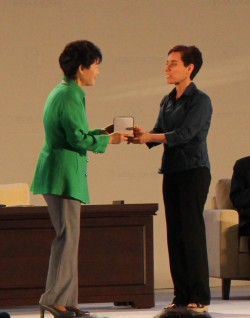수학의 노벨상 ‘필즈상’ 처음으로 여성 수학자에게 돌아가 First female winner for Fields maths medal
최영준 동아사이언스 기자 jxabbey@donga.com 제공

이란 출신 미 스탠퍼드대 교수인 마리암 미르
자카니가박대통령으로부터 필즈상을 수상하고
있다.최영준 동아사이언스 기자
['필즈상'수상자]
마리암 미르자카니 미국 스탠퍼드대 교수
아르투르 아빌라 프랑스 국립과학연구소(CNRS) 소장
만줄 바르가바 미국 프린스턴대 교수,
마틴 헤어러 영국 워릭대 교수
[3개분야 수학상 수상자]
응용수학 분야의 공로상‘가우스상’
스탠리 오셔 미국 로스앤젤레스 캘리포니아대 교수
정보과학 분야의 상 ‘네반린나상
수브하시 코트 미국 뉴욕대 교수
수학 분야에 뛰어난 업적 상 ‘천 상’
필립 그리피스 미국 프린스턴 고등연구원 명예교수
The Fields medal is engraved with a likeness
of Archimedes,BBC
kcontents
|
‘수학계 올림픽’ 2014 서울세계수학자대회 막 올라
‘수학계 올림픽’인 2014 서울세계수학자대회(서울 ICM)가 13일 서울 강남구 영동대로 코엑스에서 막이 올랐다. 120여 개국 4000명이 넘는 수학자가 참가한 이번 대회는 21일까지 7박 8일간 열린다.
개막식에서는 수학의 노벨상인 ‘필즈상’ 수상자 4명에 대한 시상식이 열렸다.
수상의 영예는 마리암 미르자카니 미국 스탠퍼드대 교수와 아르투르 아빌라 프랑스 국립과학연구소(CNRS) 소장, 만줄 바르가바 미국 프린스턴대 교수, 마틴 헤어러 영국 워릭대 교수에게 돌아갔다.
수학 분야 3개상의 수상자도 발표됐다.
응용수학 분야의 공로상인 ‘가우스상’은 스탠리 오셔 미국 로스앤젤레스 캘리포니아대 교수가 수상했으며, 정보과학 분야의 상인 ‘네반린나상’은 수브하시 코트 미국 뉴욕대 교수에게 돌아갔다. 수학 분야에 뛰어난 업적이 있는 사람에게 주는 ‘천 상’은 필립 그리피스 미국 프린스턴 고등연구원 명예교수가 받았다.
각 상은 박근혜 대통령이 직접 수여해 ICM 역사상 최초의 여성 시상자가 됐다. 개막식 전반을 진행한 잉그리드 도브시 국제수학연맹(IMU) 회장도 여성이라는 점에서 미르자카니 교수가 상을 받은 장면에서는 여성 3명이 ICM 무대에 서는 역사적인 장면이 연출됐다.
[기사본문] http://www.dongascience.com/news/view/4996 동아사이언스 |

Adding an account of randomness to particular equations can help explain the physical interaction
between two substances, like ash and paper in a smouldering sheet
First female winner for Fields maths medal
|
By Jonathan Webb
Prof Mirzakhani went to school and university in Iran before doing a PhD at Harvard
An Iranian mathematician working in the US has become the first ever female winner of the celebrated Fields Medal.
In a landmark hailed as "long overdue", Prof Maryam Mirzakhani was recognised for her work on complex geometry.
Four of the medals will be presented in Seoul at the International Congress of Mathematicians, held every four years.
Also among the winners was Prof Martin Hairer from the University of Warwick, UK, whose work on randomness could prove useful for climate modelling.
Awarded by a committee from the International Mathematical Union (IMU), the Fields Medal is regarded as something akin to a Nobel Prize for maths. It was established by Canadian mathematician John Fields and comes with a 15,000 Canadian dollar (£8,000) cash prize.
First awarded in 1936 and then every four years since 1950, the medal is awarded to between two and four researchers, who must be no older than 40, because Fields wanted to encourage the winners to strive for "further achievement" as well as recognise their success.
The other two medals were won by Dr Artur Avila, a Brazilian mathematician who earned his PhD in dynamical systems at the age of 21, and Prof Manjul Bhargava, a Canadian-American number theorist at Princeton University.
'Icing on the cake'
Prof Dame Frances Kirwan, a member of the medal selection committee from the University of Oxford, pointed out that despite being viewed traditionally as "a male preserve", women have contributed to mathematics for centuries.
She noted that around 40% of maths undergraduates in the UK are women, but that proportion declines rapidly at PhD level and beyond.
 Prof Mirzakhani's winning work relates to convoluted mathematical constructions called Riemann surfaces
Austrian-born Prof Martin Hairer was also elected a Fellow of the Royal Society in 2014 "I hope that this award will inspire lots more girls and young women, in this country and around the world, to believe in their own abilities and aim to be the Fields Medallists of the future," Prof Kirwan said.
 Prof Sir John Ball, another British mathematician and a former president of the IMU, agreed that Prof Mirzakhani's win was "fantastically important". Speaking to BBC News from the congress in Seoul, South Korea, he said that a female winner was overdue and that Prof Mirzakhani is one of many brilliant women mathematicians.
"I think Martin has done some of the most remarkable mathematics," she said.
"What Martin's work does is it allows you to take account of randomness in a way we just didn't think was possible."
A key example is modelling how the boundary changes over time between two different substances. Prof Terry Lyons, a colleague of Prof Hairer's at Oxford, uses the example of the interface between ash and paper, when a sheet is slowly burning.
"But the sort of examples that it applies to in the longer term are boundless," Prof Lyons added, noting that climate science in particular was "where it might end up". "Martin has tackled a fundamental problem and achieved a complete step-change in our understanding of it."
Follow Jonathan on Twitter bbc |











